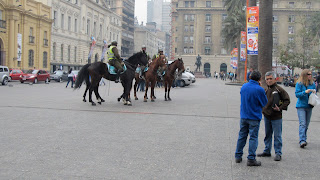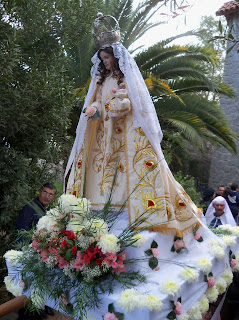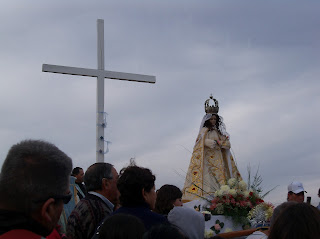Well, let’s try this: Focusing the Uruguay vs Chile
comparison, through my last day in Chile, during which Don took me through
Santiago, to see some of the highlights of Chile’s massive capital.
Our first stop, I think, was la Moneda, the Presidential palace, which was bombarded by
warplanes in the 1973 coup that toppled Salvador Allende, he of the pinewood
bust in the last installment, and installed Agusto Pinochet in power. The
Palace itself is a somewhat lowish (maybe three stories) building, not especially
impressive – perhaps in large part because it has had to be rebuilt post-1973,
and you just can’t re-created something that was made in another century with
modern construction methods. It looks very much the concrete replica of a
presidential palace.
The plaza
that it sits in, too, is a real contrast – all the buildings around it are much
larger and more modern, which contributes even more to its museum piece-like
status there. And the plaza is adorned with statues of every one of Chile’s
past presidents. Apparently, as soon as they die, the statue is commissioned
and built. What I don’t know, is when Allende’s statue went up.
Up it did go, in the end – and it’s the most modern-looking,
with Allende striding out of what seems to be bronze ether. And I find it
fascinating that the quote they’ve chosen comes from Sept. 11, 1973, from his
last radio address, which he gave from within the presidential palace as the
armed forces closed in on him and shot his supporters through the windows. So,
I’m thinking, it must have gone in post-1989, which was the end of the
Dictatorship. Because it’s hard to imagine Pinochet OK-ing that quote.
Here we do some Uruguay-Chile breakdown: Uruguay’s
dictatorship was much smaller-scale in its repression and its bloodshed. I don’t
think they killed the sitting president, and the numbes of people they tortured
or made disappear of course don’t compare – just as Chile’s numbers don’t
compare to Argentina’s, a far larger country. But the memory of that time is
just as raw in the minds of those who lived through it in Uruguay as in Chile.
And in Uruguay, I got the sense that it is utterly, completely over – that
those who perpetrated it are in jail, that the most popular politicians and
parties in the country are now the very ones who were persecuted back in the
70’s. Chile, on the other hand, still feels like it’s on the brink of
something. Maybe I was projecting, there in Santiago; maybe it wasn’t this way
in truth, and I was just seeing things. But there were a loooooot of carabineros, Chile’s national police, walking the beat in the
Capital, a lot of them on horseback. Their uniforms are smart and intimidating,
and they carry bayonets on their belts. It just felt not quite over.
From there, Don and I moved along to the plaza de armas, Santiago’s main plaza, where the cathedral is (we didn’t go in), and where
university students were staging some sort of protest / demonstration to raise
awareness: several were dressed in brides’ dresses, and were soliciting help
from the crowd. I didn’t stick around to see just what the point was; such
things make me nervous. But it was actually here that we saw the carabineros on horseback.
To compare them again: Santiago just feels bigger. Which, of course, it is. But you can tell that over
the centuries, more money has gone through there, more heavy-duty movers and
shakes have made their mark on the place than in Montevideo. Is this better? No
– I don’t think so. If you’re looking for sheer grandeur, the smaller city is
never going to outdo the bigger one. And what Montevideo lacks in firepower, it
makes up for in intimacy. The presidential offices are also on one of its main
squares, and apparently it’s common to see José Mujica, the former rebel leader
and current President, strolling out for lunch, with annoyed security guards
trying to keep up with him. He hates having them around, and really, in
Ururuay, they’re almost doubtlessly not necessary.
In Chile, oh yeah.
We walked the old city, walked to the top of the cerro
Santa Lucía, and took in the
sights. But it was hard to see them: The city was enveloped in smog, or fog, or
whichever. It wasn’t unpleasant to smell, but I did find myself coughing a lot.
Santiago is sprawling, and Don says that every time he comes through, he’s take
aback by how far out it’s growing. Not in a slum kind of way at all – just more
low cinderblock buildings, housing light industry or storage or something
Santiago’s churning economy now needs.
Montevideo doesn’t sprawl like that, or doesn’t seem to. And
its roads are less perfect, the people and businesses lining them seem a bit
more shabby than the portions I saw of Santiago. But again: I didn’t see all of
Santiago. And I saw a very large portion of Montevideo.
Don and I then went to the Museo de la Memoria, dedicated to the dictatorship: its beginning, its
fall, and its legacy – the
main reason I thought to make this
entry largely about comparing Uruguay and Chile. Because I talked a few spots
back about visiting Uruguay’s museum of the same name, and how it held
artifacts from the struggles
including Mujica’s prison uniform, which I physically touched – there
was no barrier, no sign asking me not to. It’s almost as if Uruguay is a big
family, and they expect everyone to feel that connected to their common bonds
of history. The place was small – a converted elegant country estate – and the
rooms were on the scale of one or two people looking at them at a time – in
fact, Natalia and I were, I think, the only ones there during our visit. A very
close encounter with the past.
Santiago’s museum tries to do the same sort of thing: put
the visitor in close touch with victims, with torture methods and memories,
with the scale of it all. Just as Uruguay’s had preserved the steel door of the
communist party headquarters, Chile’s had preserved a steel door from a prison
where political prisoners were kept, and a watch tower from the surrounding
walls. The architecture of the place astonished me – I have rarely been as
impressed, as moved, by the form of a building. You go deep underneath the
apparent structure to gain entry, and as you go down, you pass all 30 articles
of the UN’s international declaration of human rights, going from your right to
your left as you descend (probably not a coincidence), leading you into the
beginning, as if you’d gone back in time in an archaeological dig – doubly
meaningful, given the number of exhibitions inside about exhuming people from
mass graves. It’s a brand-new, multi-million-dollar stab at reconciliation /
redemption, and it’s hard to say they didn’t hit the mark in a lot of ways.
That was our day in Santiago. We walked a good, long walk
from there to the bus station where we’d stowed our (my) bags, then another
quick walk to where the airport shuttle takes off. And then a half-hour ride to
the airport, where Don and I said goodbye, and I boarded a flight at the
appointed time, made a connection, took two trains, and now sit on the third,
stopped in a suburb of NYC, waiting to get going again for Albany.
And I’m back to thinking about the comparisons. One that’s
been on my mind a lot:
The treatment of animals: Chileans love their dogs – but
they love them differently than the Uruguayans. In Uruguay, there are very,
very few street dogs that truly live there. The vast majority are behind the
walls and the gates of the houses they guard, and for the most part they stay
there. Some are gallavanters, but you don’t see many. Chile, on the other hand,
while it has no marauding packs of clearly wild dogs, does have a fair number
in the street in any large-ish town, including Santiago.
But they are fat!
Some, like the big German Shepard-like dog at the bus station in Los Andes,
appear to have a regular beat and a lot of people who toss them food here and
there, because they’re fat, and because they appear to be utterly at their ease
lying stretched out on the sidewalk, asleep, as dozens and dozens of people
clomp past them on their way to important daily business. But what’s so amazing
to me is that no onei bothers the
dogs. It’s almost as if it’s a sacred trust – the dog has shown its faith in
our better nature, so we respond, while not with what I might call kindness, at
least a complete lack of cruelty. Nobody, it seems, would get a kick out of
waking those dogs up, scaring them. Because nobody appears ever to do it.
Four, total, is the number of dogs I ever saw in Chile
being walked on a leash. And they were all dogs of a particular breed – not
well-loved mutts, like was often the case in Uruguay. (Although, in contrast to the "breed-dogs-are-treated-differently" narrative, on my last day
there I saw a 100% purebred Shar Pei – trotting down the sidewalk with its
friends, no collar, having a grand old time. And as Don put it, "Sometimes you'll be way out in the middle of the campo and randomly see a dog trot by wearing a sweater.") So on that level, Uruguayans love
their dogs more like Americans love them. But they’re less free. And it’s not
like Chileans don’t love them. It’s a different, somewhat more remote
relationship.
And speaking of remote relationships – In Chile, people
absolutely teem together. They seem to really dislike being alone. It’s maybe a
little skewed, given that I was there and Don and Bridget were showing me
around to their various friends, so of course I went to lots of dinners in lots
of houses where there was conversation and card-playing and jocularity. And just about everything I saw in Chile was in the countryside, too – mostly, in Uruguay, I was in Montevideo, where folks tend to
lead more urban lives, as they probably do in Santiago. But there just seemed
to be a need to be together among Chileans, that I didn’t’ sense neary as
strongly among the Uruguayans. Lots of people talk about how Uruguay and
Argentina seem more Europe-oriented, and maybe this is what they mean: that
their sense of space and intimacy seems more at place in Germany or Holland
than in Mexico. But honestly, I think there’s something deeper in there that
lurks behind those observations. I think this communal nature of the Chilean’s
being has come down through the generations along with their black, black hair, their square torsos, and their darker skin. I think it’s from the Indian side of the family, which
in Uruguay is far, far less prominent.
I noticed it in the hand gestures, for example. It’s
difficult to describe in words, but when a Chilean is talking about something
that isn’t significant, but which one would expect to be so, he or she will
often hold up one hand – usually the right – about chest-high, close in to the
body, with the fingers curled back toward the chest, and tending to rotate
slowly up toward the chin. And then suddenly they’ll flick their hand outward
and upward, as if swatting away a fly with their fingertips, leaving the hand,
at the end of the gesture, palm-out and flexed backward toward the face, held
now a little higher, maybe neck-high. It struck me as such an Ecuadorian
gesture – and something I do not think I saw once in Uruguay.
Uruguayans,
meanwhile, will pinch the tips of their index finger and their thumb together
and raise them slowly while making a precise point, up to eye level, and when
the very most crucial syllable is uttered, bounce that little imaginary needle
downward to make emphasis on the precision and exactitude of the location of
their most important sound, while popping the index and thumb apart from each other as the downward stab happens. I never saw a Chilean do this. The first seems
very, very Indian to me, and the second, very Italian.
In Chile, a strong point is made by holding the right index finger high in the air, about ear level, off to the side of the head, and holding it there, still, for just a moment. No wagging, no waving. It's just there, stolidly alone. And then it simply falls. Evo Morales does this; Ecuadorians do this. I never saw a Uruguayan do this.
I’ll never be able to prove it. But the Chileans have an
appreciation for dour, sad Andean music; houses where the quality of the construction
is just about last on the priority list - where wood is still used to make the
bread because a house doesn’t smell like a home unless it’s smoky. And
Uruguayans like to pile into long, narrow cafes and eat slice after slice of
pizza as it’s brought out to them. They are not alike, these folks, in many
ways. And I think it’s reflected in which side of the mestizo family, Mom’s
(the Indigenous) or Dad’s (the European), holds sway, both in their blood, and
in their cultural heritage, which have come down to them in roughly equal
doses.
I make no judgment as to which is better, please keep in mind. Both Chile and Uruguay are fascinating, and filled with warm, wonderful people whom I hope to know for years to come, and I would be happy to bring my family to either for an extended stay. Which one we would pick, would depend on what we wanted to get out of the experience. If I wanted to live in a city, I'd choose Montevideo, for its safety, predictability, and clean air. Countryside? It would be very hard to say no to being within striking range of Flaco's house, Nacho's house, Gladys' house, and of course Lucy and Wenceslao's house.
"But you didn't spend time in a Chilean city! How can you choose Montevideo?"
"And you didn't spend time in the Uruguayan campo! We're just as great out here!"
Well, then. I'll have to get back and compare them more closely, won't I?
I will leave off there for now. It’s 2:37 PM, and I’m
scheduled to see my little ‘uns (all three of them) at the train station in
Albany in under an hour. I’m off to freshen up – and see one more time if I
can’t locate that damned camera, which I think, I shudder to admit, I left on a
plane today. It’s a terrible way to end the trip, but at least I do it on time,
and at home.






















































